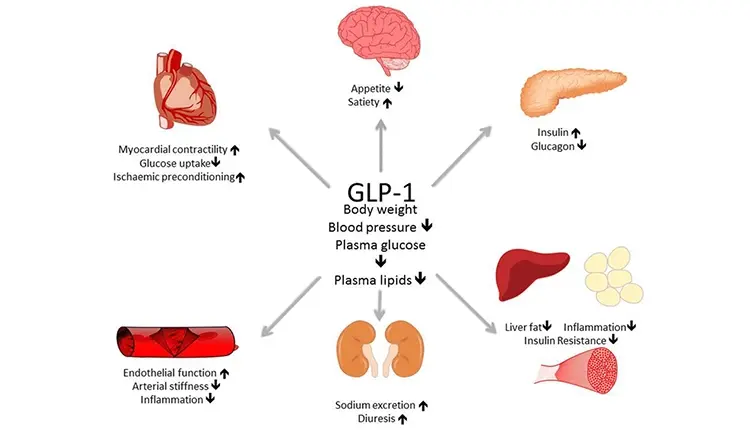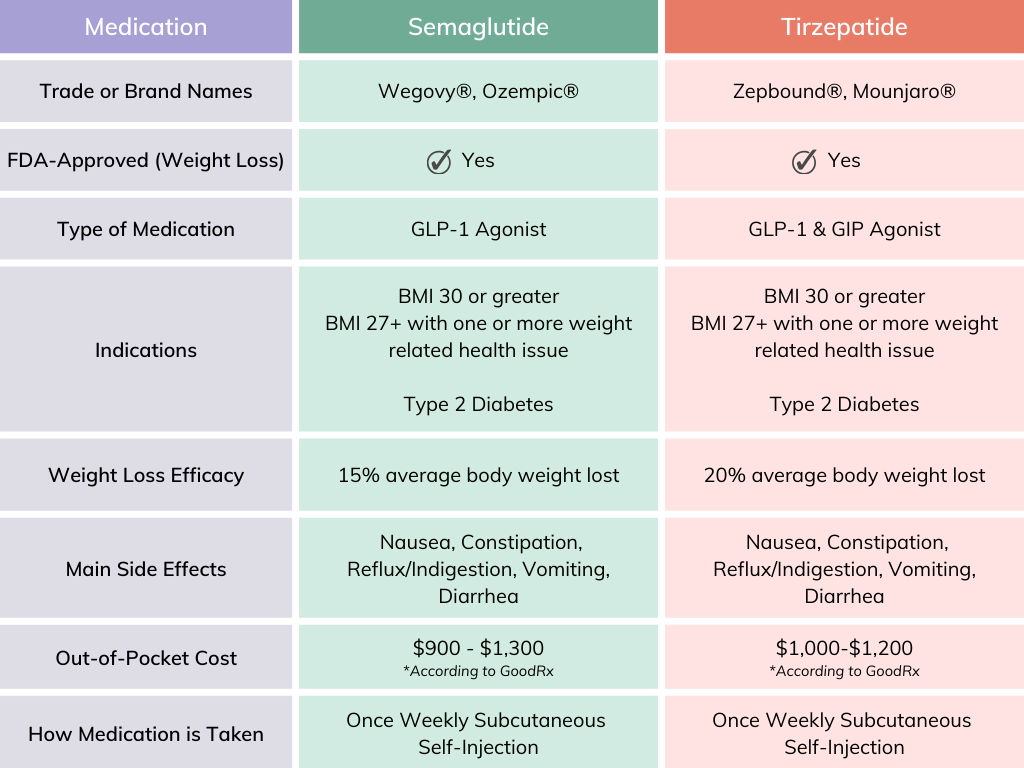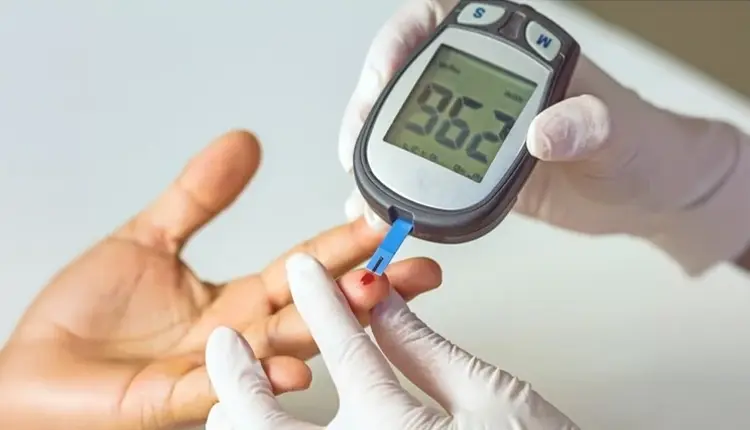Key Takeaways
- Tirzepatide, compared to semaglutide, shows superior results in weight loss and blood sugar control due to its dual receptor action targeting both GIP and GLP-1 receptors.
- Switching from semaglutide to tirzepatide involves a strategic transition with careful dosage adjustments and monitoring of side effects to ensure a seamless changeover.
- While tirzepatide offers enhanced efficacy, individual patient needs, health goals, and financial considerations, including medication costs and insurance coverage, play crucial roles in deciding whether to switch medications.
Switching from semaglutide to tirzepatide could offer improved weight loss and blood sugar control. If you’re curious about the benefits and the transition process, this article covers essential insights, practical tips, and what to expect during the switch.
Understanding the Basics of Semaglutide and Tirzepatide

Delving into the realms of semaglutide and tirzepatide, one discovers not just medications, but allies in the pursuit of wellness. Both heralded for their roles in weight loss and blood sugar control, these two are more than just drugs—they represent a beacon of hope for those battling obesity and type 2 diabetes.
As receptor agonists, they engage with the body’s chemistry in intricate ways, and understanding their mechanisms is the first step in harnessing their power.
What is Semaglutide?
Semaglutide, the active ingredient in brands like Ozempic® and Wegovy®, is a glucagon-like peptide 1 (GLP-1) receptor agonist with the following benefits:
- Controls blood sugar
- Encourages weight loss
- Emulates the natural GLP-1 hormone
- Triggers insulin production
- Stifles glucagon release
- Decelerates gut movement
Administered just once weekly, this medication became a game-changer, especially after its 2021 approval for weight loss under the brand name Wegovy.
What is Tirzepatide?
Tirzepatide, the star component of Mounjaro®, takes it a step further by targeting both glucose-dependent insulinotropic polypeptide (GIP) and GLP-1 receptors. This dual action means it:
- Enhances insulin secretion
- Suppresses glucagon release
- Fosters glucose utilization
- Promotes satiety
These are key factors in metabolic regulation.
With once weekly tirzepatide dosing and a broader receptor engagement, this medication stands out for its comprehensive approach and efficacy in both blood sugar control and weight management.
Comparison Chart

Reasons to Consider Switching
Amidst the success stories and clinical breakthroughs, one may wonder why a switch from semaglutide to tirzepatide would even be on the table. The answer lies in the pursuit of enhanced results and personalized care. For some, the switch could mean the difference between good and great, between improvement and transformation.
It’s not just about what works—it’s about what works best for you.
Enhanced Weight Loss Results

The quest for weight loss can be arduous, yet tirzepatide has emerged as a beacon of hope, showing greater weight loss results compared to semaglutide. With clinical trials revealing an average weight loss of 21% over 72 weeks, tirzepatide might be the key to unlocking a new level of weight reduction.
For those who’ve hit a plateau with semaglutide, this shift could reignite their weight loss journey.
Improved Blood Sugar Control

Tirzepatide’s edge extends to blood sugar control, with its dual receptor activity potentially providing superior glycemic management. The SURPASS-2 trialis a testament to its prowess, showcasing significant outperformance in reducing A1C levels over semaglutide.
This could be a game-changer for individuals aiming to lower blood sugar and achieve tighter glucose control, as it directly impacts their blood glucose levels.
Individual Health Needs
Beyond efficacy, individual health needs carve a path to the ideal medication choice. While both semaglutide and tirzepatide boast cardiovascular benefits, specific health conditions may tip the scales. Semaglutide’s cardiovascular improvements are well-documented, including reductions in heart-related incidents, but tirzepatide’s comprehensive benefits, such as improved lipid profiles and insulin sensitivity, cannot be overlooked.
The choice between the two hinges on personal health goals and the nuances of one’s medical profile.
Clinical Insights on Transitioning
When contemplating the switch from semaglutide to tirzepatide, the journey is as critical as the destination. This transition, woven with clinical insights, requires a strategic approach—starting with a clean break from semaglutide, followed by a carefully calibrated introduction of tirzepatide.
The process is not without its complexities, but with meticulous dosage adjustments, monitoring, and side effect management, it can lead to a seamless and successful changeover.
Initial Dosage and Administration
The initial dosage and administration of tirzepatide are cardinal in the transition process. It’s pivotal to start with a lower dose, even for those previously on higher semaglutide doses, and incrementally increase every four weeks until finding the therapeutic sweet spot—usually around 15 mg for weight loss.
The leap begins 7 days after the last semaglutide dose, signaling a new chapter in one’s weight loss journey.
Monitoring and Adjustments
As with any voyage, the path from semaglutide to tirzepatide is marked by checkpoints—frequent blood glucose monitoring being one. These readings guide dosage adjustments to skirt hypoglycemia and ensure the transition is as smooth as the insulin it aims to regulate.
Regular follow-up appointments become the lighthouse, ensuring that the patient stays on course, adjusting dosages based on effectiveness and tolerance.
Managing Side Effects

The transition may bring waves of side effects, with gastrointestinal issues at the helm. Navigating these waters requires anticipation and strategy—modifying dietary habits and adjusting to the new medication’s digestive effects are paramount.
While both medications can cause similar side effects, tirzepatide’s dual receptor activity might initially intensify them, demanding clear communication and proactive management.
Comparing Efficacy and Safety
In the pursuit of optimal health, the comparison of efficacy and safety between tirzepatide and semaglutide illuminates the path forward. A comparative analysis reveals tirzepatide’s superior performance in weight loss and glycemic control, but when it comes to safety, the tapestry is more nuanced.
While side effect profiles are largely similar, individual responses to each medication can vary, painting a complex picture of risk and reward, including potential injection site reactions.
Weight Management Outcomes
Tirzepatide has eclipsed semaglutide in the arena of weight management outcomes. Studies, including the landmark SURPASS-2 trial, have showcased tirzepatide’s remarkable ability to drive weight loss, with some patients experiencing up to three times more effectiveness compared to Ozempic within a year.
Glycemic Control
Glycemic control is a cornerstone in managing diabetes, and here, tirzepatide may have the upper hand. It’s been shown to lower HbA1c levels more effectively than semaglutide, providing a potentially brighter outlook for those seeking stringent blood sugar management.
Side Effect Profiles
Although tirzepatide and semaglutide share a similar constellation of side effects, primarily gastrointestinal in nature, tirzepatide’s unique receptor activity might initially amplify these experiences. Furthermore, higher doses of tirzepatide have been linked to more serious adverse effects, emphasizing the need for careful consideration based on patient history.
Practical Tips for a Smooth Transition
Embarking on the transition from semaglutide to tirzepatide is not a leap of faith but a calculated move. To ensure a smooth transition, practical tips like setting realistic goals, staying informed, and enacting lifestyle changes can make all the difference.
These guideposts help patients, healthcare providers, and healthcare professionals navigate the change with confidence and clarity.
Setting Realistic Goals
Realistic weight loss goals anchor the weight loss journey. They serve as a compass, guiding patients through the ebbs and flows of medication transitions and their efforts to lose weight, as they experience body weight changes.
A clear understanding of how semaglutide and tirzepatide work, along with their different side effects, helps patients set achievable targets and maintain treatment adherence.
Staying Informed and Supported
Information and support are the sails that carry patients forward during the switch. Staying abreast of potential side effects, understanding the nuances of the new prescription, and accessing support from healthcare specialists can help patients lead their way through the transition week by week. Consulting with a healthcare provider is crucial in this process.
Lifestyle Modifications

To enhance the efficacy of tirzepatide, lifestyle modifications act as a catalyst. Regular physical activity and dietary adjustments not only complement the medical weight loss treatment but amplify its metabolism-boosting effects.
Cost and Insurance Considerations
Financial considerations weigh heavily on the decision to switch medications. Cost and insurance coverage can either pave the way to a new treatment or present hurdles. Understanding the financial landscape is crucial in making an informed decision about transitioning from semaglutide to tirzepatide.
Comparing Medication Costs
When comparing the costs of these medications, tirzepatide may appear as a more economical choice over the course of treatment. The price of medication is not static; it fluctuates based on dosage, quantity, and insurance plan specifics. Such variables must be considered to accurately gauge the financial investment of each medication.
Navigating Insurance Coverage
Navigating insurance coverage is akin to deciphering a complex map. Patients must verify their insurance policy, understand pre-authorization requirements, and explore patient assistance programs to minimize out-of-pocket costs for tirzepatide.
How Long Until You See Results?
As with any medical treatment, the burning question often is: how long until results manifest? With tirzepatide, patients may notice changes in blood sugar levels and weight loss within four to six weeks, with significant HbA1c reduction typically observed after 12 weeks. Consistency and adherence are key to unlocking these benefits.
Summary
In conclusion, the decision to transition from semaglutide to tirzepatide is multifaceted, hinging on factors such as efficacy, safety, individual health needs, and financial considerations. Clinical insights suggest tirzepatide may offer superior weight loss and glycemic control, but the journey involves careful planning, realistic goal-setting, and proactive management of side effects. As patients chart their course, staying informed, supported, and engaged in lifestyle modifications will enhance the likelihood of a successful transition.
Frequently Asked Questions
Meet the Author

Bradley Keys
Bradley Keys is an accomplished writer who has covered a wide variety of health, nutrition, and wellness topics. He graduated with a Bachelor of Science from Florida State University, and has extensively explored a diverse range of subjects within the realms of health, wellness, and nutritional supplementation, showcasing a broad and in-depth understanding of these interconnected fields.
Reviewed by :

Dr. Majid Sabour
Dr. Majid Sabour, MD, is a renowned expert in medical weight loss and the founder and medical director of Gent's Doctor clinic in Beverly Hills, California. With over 25 years of experience, Dr. Sabour is board-certified in family medicine and specializes in helping patients achieve their weight loss goals through personalized medical treatments. He graduated from Zaporizhzhia State Medical University in Ukraine and completed a family medicine residency program with Columbia University and Cornell at New York-Presbyterian Hospital in Manhattan. Licensed in both New York and California, Dr. Sabour is dedicated to providing comprehensive weight loss solutions that promote overall health and well-being.











